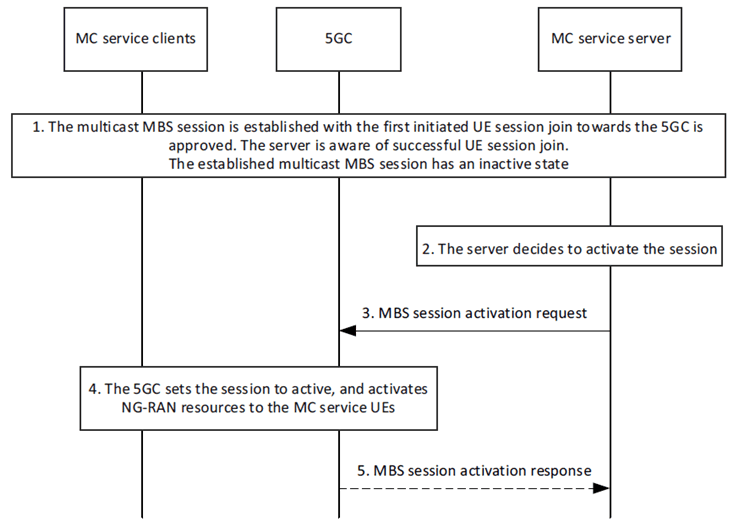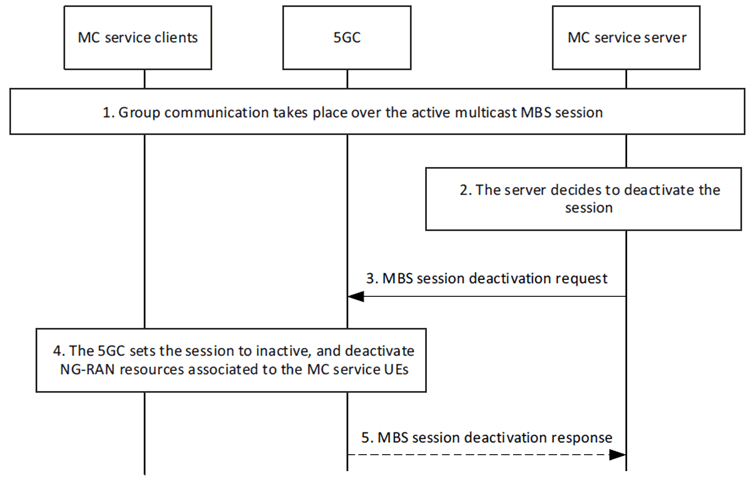Content for TS 23.289 Word version: 19.0.0
0…
4…
4.7…
4.7.4…
4.8…
5…
5.4…
6…
6.3…
6.3.2…
7…
7.2.4…
7.3…
7.3.3…
7.3.3.2…
7.3.3.4…
7.3.3.5…
7.3.3.7…
7.3.3.8…
7.3.3.9…
7.3.3.10…
7.3.3.11…
7.3.3.12…
7.3.3.13…
7.4…
7.5…
7.6…
A…
7.3.3.4 Request to activate / de-activate multicast MBS sessions
7.3.3.4.1 General
7.3.3.4.2 Multicast MBS session activation procedure
7.3.3.4.3 Multicast MBS session de-activation procedure
...
...
7.3.3.4 Request to activate / de-activate multicast MBS sessions p. 66
7.3.3.4.1 General p. 66
In case of multicast MBS sessions, the members affiliated to a certain MC group need to initiate a UE session join request towards the 5GC in order to receive the MC media sent via the associated MBS session. The UE session join request enables the reservation of NG-RAN resources for the members of the MC group. However, it is not necessary that the MC media is delivered over the whole time the multicast MBS session is associated to the group under consideration. Therefore, the MC service server is able to efficiently utilize and control the reservation of radio resources based on the availability of MC data to be delivered via the activation and de-activation procedure. This presents more flexibility and efficient use of resources different from LTE.
The most suitable scenario to activate/de-activate a certain multicast MBS session is based on whether there is an MC group call, e.g., MCPTT group call, taking place over that associated MBS session to the MC group. In this manner, the MC service server can activate the associated multicast session once an MC group call takes place, then deactivate it once the MC group call is over. Whether the multicast session is activated (i.e., in an active state), or de-activated (in an inactive state), the MC group is associated to the multicast session and its members are within a UE session join.
The MBS session update request with the requested MBS session status is triggered by the MC service server either directly towards the MB-SMF or indirectly via NEF/MBSF.
7.3.3.4.2 Multicast MBS session activation procedure p. 66
The procedure shown in Figure 7.3.3.4.2-1 presents the multicast MBS session activation procedure triggered by the MC service server.
Pre-conditions:
- MC service clients are attached to the 5GS, registered and affiliated to the same MC service group X.
- The MC service server has directly performed (or via NEF/MBSF) an MB-SMF discovery and selection, unless the corresponding information is locally configured.
- The MC service server has decided to use a multicast MBS session for MC service group communications associated to MC service group X.
- The MBS session is created and announced to address MC group communication related to the associated MC service group X with certain service requirements and optionally with a certain service area.

Step 1.
The multicast MBS session is established as the first UE session join request, which is initiated by the first MC service UE towards 5GC, is granted. At this stage, the multicast MBS session is established with an inactive state.
Step 2.
The MC service server decides to activate the multicast MBS session as MC data is needed to be transmitted over the MBS session to the MC group X, as an MC group communication (e.g., MCPTT group call) is to take place over the associated MBS session.
Step 3.
The MC service sends an MBS session update request towards the 5GC, either directly to the MB-SMF or via NEF/MBSF, indicating the MBS session ID to be activated as described in TS 23.247.
Step 4.
The 5GC changes the MBS session status to "active" and finds the list of joined MC service UEs associated with the MBS session and activates the NG- RAN resources for MC data delivery as described in TS 23.247.
Step 5.
The 5GC may send an MBS session update response to the MC service server indicating that the requested multicast MBS session has been activated as described in TS 23.247.
7.3.3.4.3 Multicast MBS session de-activation procedure p. 67
The procedure shown in Figure 7.3.3.4.3-1 presents the multicast MBS session activation procedure triggered by the MC service server.
Pre-conditions:
- MC service clients are attached to the 5GS, registered and affiliated to the same MC service group X.
- The MC service server has directly performed (or via NEF/MBSF) an MB-SMF discovery and selection, unless the corresponding information is locally configured.
- A multicast MBS session is created and announced to address the corresponding MC service group with certain service requirements and optionally with a certain multicast service area.
- The MC service clients have already joined the multicast MBS session and are able to receive the MC data over the associated MBS session.

Step 1.
The group communication associated with MC service group X takes place, and the corresponding MC data is delivered over the associated multicast MBS session, hence the MBS session has an active state.
Step 2.
The MC service server decides to deactivate the multicast MBS session, as no further MC data to be delivered to the associated group, as the MC group call is over, and no further MC media is to be delivered.
Step 3.
The MC service server sends an MBS session update request towards the 5GC, either directly to the MB-SMF or via NEF/MBSF, indicating the MBS session ID to be deactivated as described in TS 23.247.
Step 4.
The 5GC changes the MBS session state to "inactive" and deactivates the radio resources associated with the joined MC service UEs as described in TS 23.247.
Step 5.
The 5GC may send an MBS session update response to the server indicating that the requested multicast MBS session has been inactivated as described in TS 23.247.